How to make a water filter with your own hands: a review of popular homemade products
Purifying water with homemade filters is a standard activity for camping and field conditions.After all, it is unwise to carry huge bottles on yourself due to the incredible physical costs. In addition, this is irrational due to the almost ubiquitous presence of the liquid component of the earth’s shell necessary for the body.
The liquid people need is indeed available everywhere, but its sanitary condition is not always compatible with consumption. But to make it very effective water filter You can do it yourself even on a multi-day route, being far from populated areas, with a minimum of available means.
We will introduce you to the most effective and easy-to-implement devices for purifying dirty water. Here you will find diagrams, recommendations and a detailed description of manufacturing technology. The material offered for review is systematized, supplemented with visual illustrations and video instructions.
The content of the article:
Why do you need to purify water?
Now various household filters are included in the list of basic kitchen interior accessories. They will do a great job if you need to filter a couple of liters of liquid. But when it comes to large volumes, handheld and household devices are useless and you have to look for a commensurate alternative.
A suspension of sand, fine clay particles, organic matter, waste products of all types of animals and microorganisms makes water from open reservoirs categorically unsuitable for drinking. The situation is the same with wells.
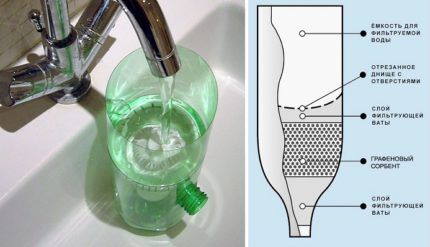
The agricultural industry annually becomes on par with the heavy and chemical industries in terms of pest levels, due to the amount of nitrates used. Thus, the use of nitric acid to fertilize the soil saturates groundwater with harmful salts.
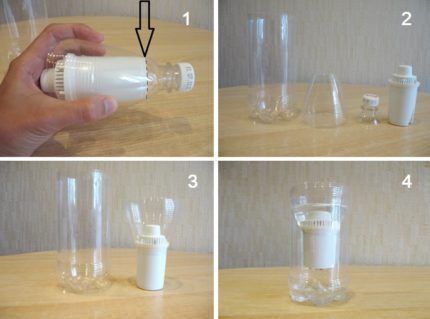
Be that as it may, even the most modern filtering equipment periodically needs to replace cleaning cassettes, let alone homemade ones. After a certain time, it is imperative to replace the makeshift system with a specialized one.
This is important to do because the water may contain pathogenic bacteria and other undesirable microflora, which are absolutely impossible to filter, and only the sanitary and epidemiological station can cope with bacteriological contamination of a river or well.
How to choose filter media?
When choosing a container for a filter, you need to carefully calculate everything, because the cleaning properties primarily depend on the correctly formed “filling”. The volume of the filter container must be such that it can easily accommodate all components.
Natural materials are widely used as absorbents, such as quartz river or washed quarry sand, gravel, activated carbon and zeolite. As you know, any filter begins with a primary coarse layer. Often this role is assigned to cotton-based fabric materials.
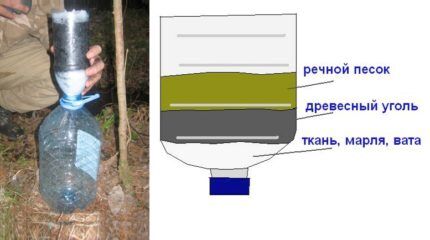
Natural materials are very impractical from a hygiene point of view. Firstly, in a humid environment, such a filter layer is subject to rotting processes, which causes an unpleasant odor. Secondly, the structure of the fabric implies very rapid contamination of the filter with unwanted particles, which increases the need to change the layer.
Much better performance is observed in synthetic analogues. More preferable in this regard is lutrasil. The material has moisture-resistant qualities and is more resistant to contamination than cotton or bandage.
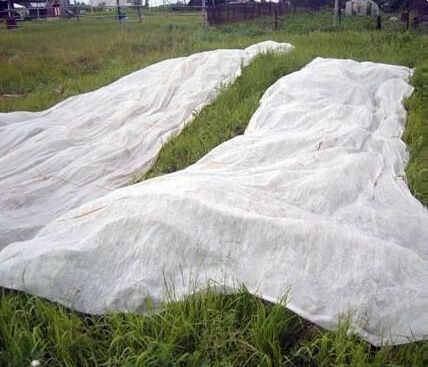
A completely budget option for a fabric filter can be considered a synthetic layer, which is used in making coffee.
Quartz sand does an excellent job of retaining small particles, as well as filtering heavy chemical compounds. While gravel, on the contrary, will better screen out large inclusions of unwanted materials. A mineral called zeolite has an incomparable cleansing effect.
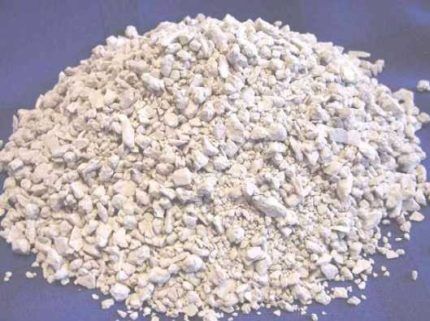
The active action of the substance will successfully cope with water pollution with metal and salt suspension, and also neutralize pesticides and other processed products of the agricultural industry.
Activated carbon cleaning devices
The most common group of homemade filters involves the use of activated carbon.The drug can be purchased at any pharmacy in unlimited quantities. Its reserves will practically not increase the weight of the luggage and will not take up much space in the backpack.
But in terms of cleaning power, coal has few rivals. It perfectly adsorbs toxic substances, absorbs an impressive range of heavy metals, and mercilessly fights harmful microorganisms.
Small-sized camping varieties
Perhaps the best quality filtration results are shown by homemade options based on activated carbon. The absorbent will equally successfully cope with the retention of both mineral formations and toxic substances.
The properties of the material include the ability to impart transparency to liquids, as well as eliminate unpleasant odors and waste products of microorganisms.
When choosing coal, you need to pay attention to the structure of the mineral. Too fine and powdery will penetrate into the water, while coarse, on the contrary, will not provide the proper level of purification.(Granular starting material should be preferred).
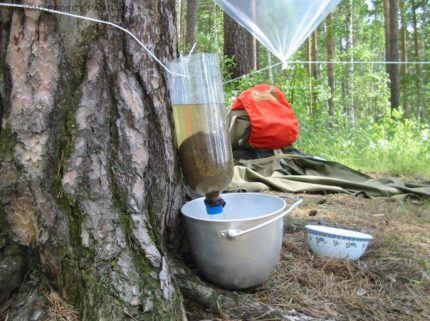
An important factor is the degree of so-called “roasting” of the coal. If you overdo this procedure, the absorbent will quickly lose all its valuable qualities.
Coal can be bought at any supermarket, or made at home. The best absorbent qualities are observed in deciduous wood, in particular birch.
It is not recommended to use coniferous trees, as the essential oils they contain can give the filtered water a pine-like smell.
To obtain coal, you need to load wood into any metal container and heat it over a fire (preferably put it in a stove). After the wood gets red hot, remove the container and let it cool - that’s it, the charcoal is ready for use in the filtration system.
A completely camp option would be a homemade carbon-based filter for water from the ashes of a burnt-out fire. If necessary, it is better to use whole pieces approximately 4 cm in length.
As a rule, anything can serve as a housing for such an improvised system, but mainly a plastic container or bottle is used for convenience.
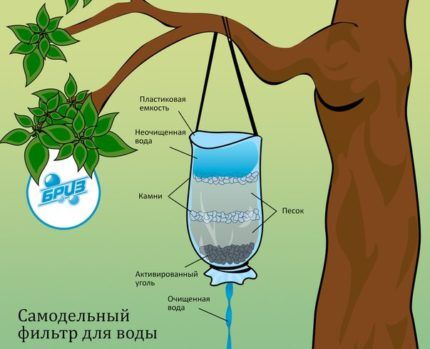
Making a carbon water purifier
Before assembly, you need to select a more optimal housing option.
For this you will need:
- Several plastic containers (bottles or PVC pipe, in some cases you can use food containers. Due to their strength, they will serve well as the base of the cartridge).
- Tools for processing plastic (various sharp objects: awl, scissors, stationery knife, screwdriver).
- Absorbent material (in this case activated carbon).
- Additional filter granules (quartz sand, gravel).
- Material for the primary fabric filter (medical bandage, gauze or coffee filter).
- Plastic covers or plugs.
To ensure the tightness of the structure, polymer substances should be used at the junctions of the modules (if the filter is multi-level and consists of several parts). Moisture-resistant silicone glue or insulating tape work well.
To install the hanging structure, you need to first cut off the bottom of the plastic bottle using a stationery knife. Then make two holes opposite each other to attach the hinges. Now the improvised body can be hung, for example, on a tree branch.
Next, you need to make an outlet valve from where the filtered liquid will flow. At this stage, the design feature depends on individual preferences. You can organize something according to the principle of a shower - make many small holes in the lid, or you can drill one large one.
The next step will be the actual installation of the components. After screwing on the perforated lid, the body is turned over or hung by the hinges. Then, the first step is to place a bandage or gauze folded several times. The use of a coffee filter is also encouraged.
In some cases, you can find designs where the role of the primary filter material is played by a fabric cover, sewn specifically to the size of the housing. This greatly simplifies the task of changing the absorbent and saves time.
It is worth paying attention to the fact that the installation of absorbent components should be done in a “pyramid” type. This means that the first step is always a fine-grained absorbent (coal), then comes a layer of quartz sand, and then comes the turn of river pebbles or gravel.
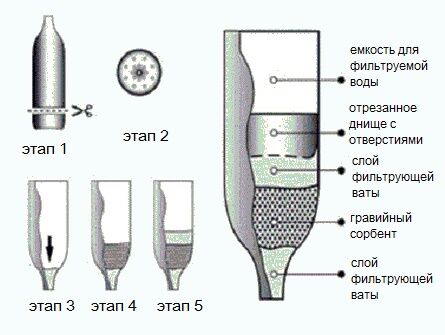
For greater efficiency, it is recommended to alternate several layers of pebbles, however, do not forget that excess material can impede the flow of water.It is better to cover the filler hole with some kind of cloth or lid to prevent unwanted objects from getting inside the cartridge.
The principle of operation of such a filter is the passive flow of water through all layers. Under the action of the granules, the contaminated liquid is cleaned and flows out of the perforated hole. Initially, you need to pass several liters of water through the filter. The first filtering procedure will wash the layers and remove contaminants.
The disadvantages of the system include the rather slow cleaning speed and the need to constantly add new liquid after completing the filtration procedure.
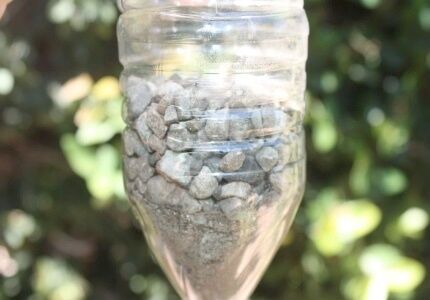
Useful homemade PVC pipe
To purify water in a suburban area, you can also make an effective purifier that can compete with factory products. It will be needed to treat water collected in mine well or in water well, but it will be especially useful if water is drawn from a river, pond or lake.
To build the structure you will need a piece of plastic water pipe and 2 containers. You can connect two bottles, where the upper segment will act as a coarse filter.

As expected, a primary layer of gauze or cotton wool is first placed inside, while some kind of mesh backing, for example, made of plastic, is constructed so that the layers do not mix.A plastic cap that can be glued into a PVC pipe is well suited for this, then drill several small diameter holes around the circumference.
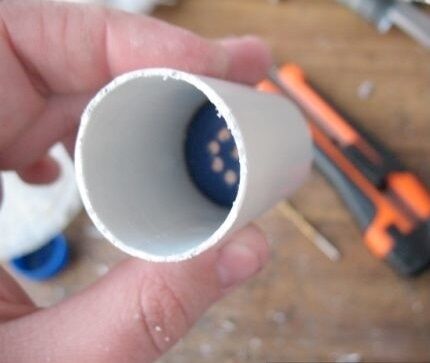
Next begins the stage of filling the initial cartridge with synthetic material (sintepon can be used).
After this, close the module again with the lid, only this time you should not resort to using glue, because this part must be removable in order to be able to replace and clean the filter material.
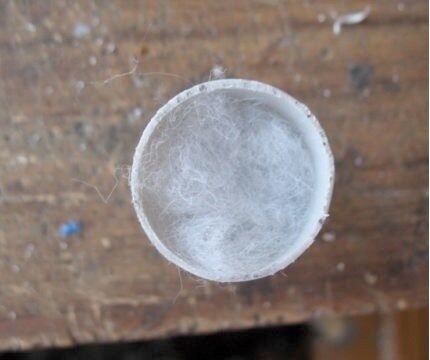
Then the turn of the plastic pipe begins. You need to cut off the neck of the bottle and secure it inside the pipe so that you can use the thread.
It should be secured tightly to avoid leaks (silicone glue works well). It is recommended to wrap the outer side and edging of the neck with several layers of electrical tape for greater strength.
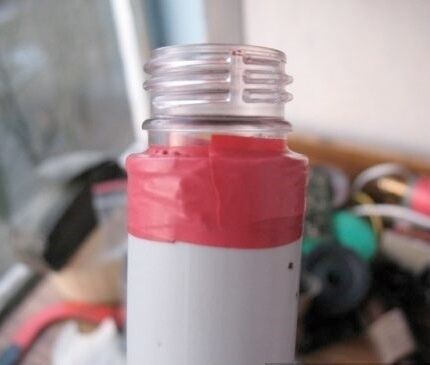
As usual, you need to insert a cap into the other end of the tube and make a perforation. A fabric layer should be placed on the inner surface of the improvised cassette.
After all the manipulations, the structure is ready to be filled with granulate (in this case, activated carbon). For better efficiency, you can alternate layers of minerals inside the pipe.
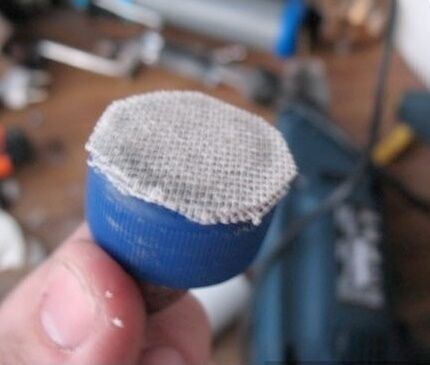
Once complete, the primary filter and carbon module are screwed together using threads. Then plastic bottles are added on both sides. That's it, the cut PVC carbon filter is ready for use.
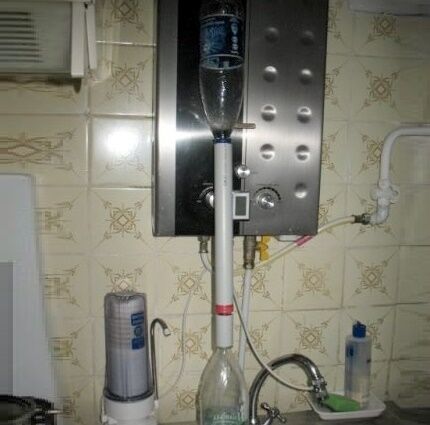
Water filter for aquarium
As you know, for the normal functioning of aquatic inhabitants, it is necessary to clean the tank in a timely manner and maintain the purity of the water. Owners of small aquariums will come in very handy with instructions on how to build a filter at home.
The body of a homemade filter for purifying hard water can be any plastic tube of a suitable diameter, including, in the absence of one, 2 syringes will work well.
Before assembly, you need to prepare some additional parts: a spray bottle (often used in bottles with detergents), a sponge with a high degree of rigidity, as well as a mechanism by which the structure will be attached to the wall of the aquarium (suction cup).
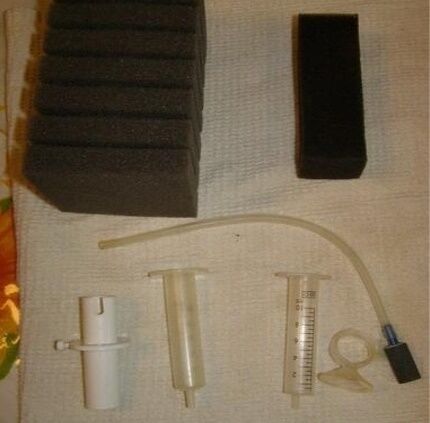
The first step is to remove the moving part of the syringe; it will not be useful. Then, using hot glue or other sealant, connect the blanks to each other, after cutting off the spouts.
For water flow it is necessary to make perforations. An ordinary soldering iron will do an excellent job of this, and if you don’t have one, you can heat any metal object, such as a nail, over the fire and make holes over the entire area of the syringe.
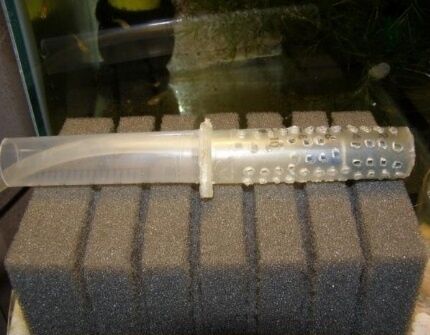
In some cases, you can put some granules into the filter capsule; the best option would be to use zeolite, because The absorbent does a good job of filtering nitrates. Next, you need to place the atomizer inside the housing, and its flexible tube should run evenly along the entire length of the cassette.
Then the improvised cartridge should be completely wrapped with a sponge and the outer layer should be secured so that it does not unwind. That's all, the power of such a filter is quite enough to purify water in a small aquarium.
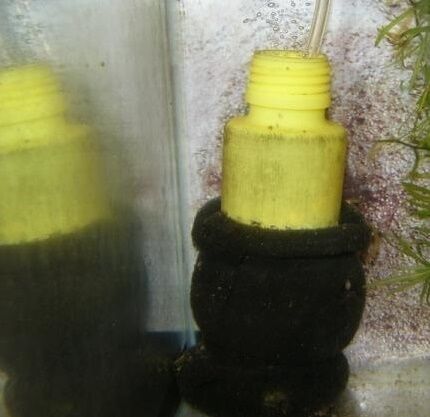
Sand option for the pool
As already mentioned, the process of constructing small-sized variations of filter systems is quite simple, however, if we are talking about a large reservoir, it is necessary to think through all the nuances of the purification system.
Many people have probably encountered the problem of “blooming” water. Most often this process is observed in the warm season, and if private pool It is also equipped with a heating system, such an opportunity can happen at any time.
It’s fair to say that the problem of green water can be completely solved with improvised means, namely, removed mechanically, but sometimes a layer of algae can sink to the very bottom and removing the surface film will not solve the problem.
In addition, not only algae can act as a pollutant, but also fallen leaves, as well as sand and all kinds of microparticles if the pool is located outside.
Faced with problems of this kind, people begin to frantically buy all sorts of detergents and cleaning products in the hope of getting rid of annoying green islands. But the active chemical action of substances can only help with the pollutant that is on the surface and in order to clean the tank to the very bottom, completely different methods are needed.
To completely clean the pool, there are special filter systems. They work on the principle of a “vacuum cleaner”, namely, they pump liters of contaminated liquid through a compressor. The filtration process is a repeated transfer of water from one part of the pool to another.
This mechanism is often used in large municipal or private institutions, where the volume of the pool sometimes reaches thousands of liters, so the best solution is an automated filtration system.
But it is not profitable for the average user to invest in such bulky equipment if, for example, it is necessary to clean only a small seasonal inflatable tank.
Just for such reservoirs there are instructions for constructing a sand filter.
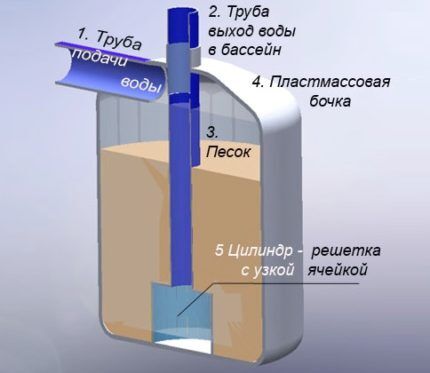
During the assembly process, you will need any container that can serve as a cartridge. The water tunnel from the primary filter can be made from a plastic pipe 2 meters long (if the pool is large).
You also need to take into account that the tunnel design involves a 90-degree rotation, so a PVC corner is needed. The inner diameter of the cartridge and pipe should be about 50 mm.
A threaded bushing with a diameter of M10 can be used as a support pin for cleaning modules. The convenience of this design allows you to connect several filter cassettes into one, which turns a regular filter into a multi-level one. This increases absorption efficiency and ultimately results in cleaner water.
At the first stage, you need to make two holes (it is better to use a hammer drill).
The first is in the filter plug, and the second is in the PVC corner, then connect the two parts using a pin and nut. A water compressor should be attached to the other end of the tube. The power of the equipment should be selected based on the volume of the pool.
In order for the filter to float, it is necessary to make a special foam backing.
The purification process is circular, and occurs by taking water from the lower layers of the pool and pumping it through the filter using a pump.
The advantage of this design is the absence of additional elements for releasing filtered water, as well as the possibility of replacing the cartridge. It is better to carry out the rinsing procedure over a separate container to avoid dirty liquid getting back into the pool. It is better to use a bucket for this.
In addition, the cost of this installation is significantly less than branded analogues. Everything you need can be purchased at specialized retail outlets, for example, a compressor is sold in any pet store, PVC pipes and corners in construction supermarkets, and a replacement cartridge in the markets in the plumbing department.
A big advantage when creating a floating filtration system is the freedom of design. If you have decorative components on hand, you can disguise the filter as any object that fits into the composition of the pool, for example, a ship.
Homemade water filter
At home, anyone can build an installation consisting of three containers connected in series. Such a water filter works only under a certain pressure of the water supply system.
Plastic or glass containers can be used as future cassettes, and the segments must be connected using a ¼-inch adapter nipple.

For convenience, the adapters have entry/exit guides. They will make sure that the assembly process is successful. Another important point is the tightness of the installation. To avoid leaks, it is recommended to wrap each thread in Teflon tape and seal the joints with synthetic material.
A filter of this type is connected to the system as a tee and connected in series with the water supply pipes. The same coal can be used as granulate. It will clean raw water from harmful microparticles and prevent the appearance of scale on the heating elements of an electric kettle and washing machine.
Conclusions and useful video on the topic
After some time, you will have to replace the homemade system with a more professional one. This is due not only to the wear and tear of old parts, but due to their low absorption and purification efficiency in relation to microorganisms contained in water.
To ensure the sterility of the reservoir, modern filters are equipped with a mineralizing system. Before buying equipment, it is worth testing the water in laboratory conditions for mineral content and then, based on the results of the examination, choosing a filter with the appropriate mineral composition.
Homemade equipment does not have such a function, so after the cleaning stage it is recommended to boil the filtrate. Also compare the power of the filter with the water pressure. Incorrect calculation of the water pressure intensity in relation to a homemade filtration system can affect the performance of the equipment.
Video #1. The process of making a simple filter from a plastic bottle:
Video #2. This video will help those who want to make a miniature version of a water filter:
Video #3. Construction of a filter for a personal pond:
There really is no limit to people’s ingenuity, and this is clearly confirmed by the variations of the presented filters. A wide selection of materials, fillers and an abundance of shapes are suitable for any case where you need to quickly purify water.
Would you like to share your own version of an effective homemade filter or ask a question? Please write comments in the block located below the text of the article. Share useful information, ask questions, post photos related to the topic of the article.




A homemade filter was made in the summer at the dacha, using a five-liter bottle and coal (in bags for the barbecue), the water turned out to be perfectly clean and tasty. We even tried to filter water from the lake, with excellent results. I think such a filter is simply irreplaceable even on vacation, although the design is not eternal and you need to re-make it every time, if you wish. You need to try some of the methods suggested in the article. I think the result will also be good.
Often on a hike there is not enough drinking water: it is not possible to take as much of it as required, so you have to get out and “clean” the water yourself. Usually I prefer to make a structure from 5-liter bottles, use coal as an absorbent, and put a layer of moss on the prefilter. But if I have cotton wool with me, I use it. I also made a filter for a summer house, the body was made from pipes, and a layer of coal and a layer of zeolite were used as filling.
I wouldn’t trust myself to make a filter for water purification; it’s better to buy some high-quality option that has already been tested by someone in practice in a normal store. Moreover, they are not that expensive. It's another matter if you understand this and are able to make a good filter yourself. There is no need for any stores here anymore, and there is a good saving of money. But there are situations, for example, on a hike, when the use of homemade filtering devices is vital. However, you need to pass water through them several times and be sure to boil them after processing.
In any case, a homemade filter will be inferior to a store-bought one due to its shorter resource and short service life.They will do as a temporary solution, but they cannot completely replace factory filters.
There is no point in passing water through the same filter several times. Passing through the upper coarse layers of the filter, the water will become contaminated again. You can make a cascade of filters in which the 2nd and 3rd filters of the cascade will not have coarse cleaning elements at all (stones, moss, top fabric), but will have a deeper layer of fine sand and coal. The purity of the sand also plays a role; if the sand is from the same river where the water was taken, then obviously it must be cleaned separately. In general, imagination and engineering ingenuity will help you!
Simply elementary, “Watson.” Take two 5 liter plastic bottles. cut out the bottom of one of them, and make 10-20 holes d - 3mm in the lid. In the second bottle, cut out the top part so that the first bottle can be inserted into it with the cut bottom up. In the lower part, 1 cm from the bottom, insert a water tap (preferably a screw tap so that it opens easily, or just a flexible tube so that during filtration you can lift the end of the tube up so that the water does not pour out on its own.
First place a folded gauze napkin in the cut out bottom of the top bottle, and then pour half a jar of barbecue charcoal. Then again put a double folded gauze napkin and pour water from the tap. As you filter, add water to the top bottle. Drain the filtered water through the tube of the bottom bottle. In this way, you can qualitatively filter up to 500 liters of water (2-3 months), after which you disassemble the jars, wash them with soda, and change the contents (the filter of the top jar). Previously, such a factory-made filter was called “Rucheek”.Good luck to you, . Anatoly Gennadievich.